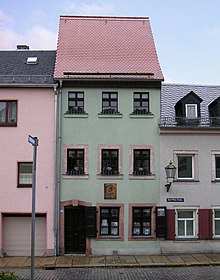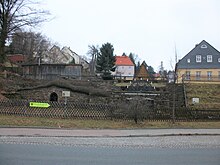Ernstthal (Hohenstein-Ernstthal)
|
Ernstthal
Large district town Hohenstein-Ernstthal
Coordinates: 50 ° 48 ′ 5 ″ N , 12 ° 43 ′ 7 ″ E
|
||
|---|---|---|
| Area : | 89 ha | |
| Incorporation : | 1898 | |
| Postal code : | 09337 | |
| Area code : | 03723 | |
|
Location of Ernstthal in Saxony |
||
Ernstthal is a district of the large district town Hohenstein-Ernstthal in the district of Zwickau in Saxony . In 1898 it was united with the mountain town of Hohenstein to form the town of Hohenstein-Ernstthal.
geography
Geographical location and traffic
Ernstthal forms the eastern part of the city center of Hohenstein-Ernstthal. To the north of the district is the Pfaffenberg , ( 479 m above sea level ) which lies on the transition from the northern edge of the Erzgebirge basin and the southern edge of the central Saxon loess loam hill country . The Pfaffenberg belongs to the "Pfaffenberg – Oberwald" nature reserve. The Goldbach rises in Ernstthal and drains over the Lungwitzbach into the Zwickauer Mulde .
The historical origin of Ernstthal with the Church of St. Trinity at Neumarkt is in the west of the district. With the streets Lampertusweg , An der Halde and Zechenstraße , the northern part points to the former mining around the mountain town of Hohenstein. There is a new building area in the southern part of Ernstthal .
The federal motorway 4 runs north of Ernstthal and the Dresden – Werdau railway line runs in the southern part of the city . The Hohenstein-Ernstthal station located in the district Hohenstein.
Neighboring places
| Langenberg | Grüna | |
| Hohenstein |

|
Desert fire |
| Oberlungwitz |
history
About 200 years before Ernstthal was founded, the Hohenstein settlement ("uff den Hohen Stein"), southwest of the Pfaffenberg, was built around 1490 with the discovery of silver . In 1510 it was given the status of a mountain town . Northeast of the city arose u. a. the shafts "Lampertus", "St. Anna ”and“ God's will ”. The origin of Ernstthal lies in a forest house, which the merchant Jacob Simon built in 1679 on the "upper Haynholz" east of Hohenstein. After the plague broke out in Hohenstein in 1680 , Jacob Simon's son Johann Simon was banned from entering Hohenstein. Thereupon he acquired larger building plots in the woods east of Hohenstein, which he then sold to settling weavers. The two Counts Christian Ernst von Schönburg (1655–1718) and August Ernst von Schönburg (1666–1729) supported Simon in the construction of the settlement "at the forest places", which was originally in the corridor of Oberlungwitz . It was first named "Neuhohenstein", then finally "Ernstthal", after the two Counts Christian Ernst and August Ernst von Schönburg, who at that time were the owners of the Schönburg rule of Glauchau , Hinterglauchau . Ernstthal belonged to this, although it was territorially separated from this. In contrast to this, Hohenstein belonged to the office of Fordglauchau . Only one building in Ernstthal belonged to the Schönburg rule of Waldenburg .
The further development of the place, which received market rights in 1694 and town rights in 1687 , took place according to plan, similar to the places Oberwiesenthal , Scheibenberg and Callnberg . In 1687 the foundation stone was laid for the St. Trinity Church, consecrated in 1689. In 1688 it was separated from the Oberlungwitz parish . The church received its first extension in 1717, and a second in 1766. In 1695 Ernstthal received a school that was part of the cantorate that still exists today. As in Hohenstein, linen weaving and bleaching were established in Ernstthal, and later stocking knitting. These formed the basis for the textile industry that soon dominated. The hosiery received the first guild letter in 1735. The city already had 2000 inhabitants by 1815. In the eastern corridors of Ernstthal, two shafts were sunk on hard coal in 1822 , which were quickly abandoned due to their low productivity. The famous writer Karl May was born in Ernstthal on February 25, 1842 . The Karl-May-Haus in the house where he was born, south of Neumarkt , has been a reminder of him since 1985 . Ernstthal has had a volunteer fire brigade since 1856. With the opening of the Chemnitz - Zwickau section of the Dresden – Werdau railway line, Hohenstein-Ernstthal station was opened to traffic on November 15, 1858 . Initially, however, the station belonged neither to Hohenstein nor to Ernstthal, but to Oberlungwitz Abbey . The station property was later bought by Hohenstein.
After an administrative reform was carried out in the area of the Schönburg recession in 1878, Ernstthal joined the newly established Saxon governorate of Glauchau in 1880 . The old Ernstthal town hall, which also housed the “Zur Tanne” restaurant, was demolished in 1886. A few years later, in 1898, the union with Hohenstein to form the city of Hohenstein-Ernstthal, which received a new city coat of arms. In 1905 the Pestalozzi School was established in place of the old Rector's School. In an area exchange between Oberlungwitz and Hohenstein-Ernstthal, the district of Ernstthal was assigned the Windberg (northeast of Ernstthal) and Neuoberlungwitz (south of Ernstthal, corridor of today's new building area Sonnenstrasse). With the closure of the “St. Lampertus ”mining ended in Hohenstein-Ernstthal in 1911. Except for the Huthaus built in 1846, all buildings were demolished. The hut has been used as a club house since 1998 by the "Freundeskreis Geologie und Bergbau Hohenstein-Ernstthal eV", founded in 1996. In 1911, the Erzgebirgsverein built the mountain inn on the Pfaffenberg . The first mountain festival also took place this year. Between 1921 and 1923, the hosiery knitting factory of the company "ETAM" known as "Vinora" was established on Dresdner Strasse. Another weaving mill, later known as “ VEB MALITEX”, was built between 1946 and 1948 at the location of today's Kaufland supermarket .
Since the second district reform in the GDR in 1952, Ernstthal belonged as part of the district town of Hohenstein-Ernstthal to the Hohenstein-Ernstthal district in the Chemnitz district (renamed Karl-Marx-Stadt district in 1953 ). Between 1978 and 1994 the new building area on Sonnenstrasse was built in the south of Ernstthal . Today's Karl May Elementary School was opened in 1980 as the Wilhelm Pieck High School and later continued as the Herderschule. In 1990 the residential areas on Scheerwiese, Logenberg, Fuchsgrund and Hasenhügel were built.
Since 1990 Ernstthal belonged as part of the district town Hohenstein-Ernstthal to the Saxon district Hohenstein-Ernstthal . Since the loss of the district seat in 1994, the city of Hohenstein-Ernstthal has been awarded the title of Large District Town. She came to the Chemnitzer Land district in 1994 , which was added to the Zwickau district in 2008. In the week of June 4 to 12, 2005, the Ernstthal district celebrated its 325th anniversary. The highlight of the festival week was an 810 meter long parade on June 12th.
Attractions
- St. Trinity Church
- Karl May House
- Visitor mine “St. Lampertus "
- Pfaffenberg
Personalities
- Karl Heinrich Ludwig Pölitz (1772–1838), historian, born in Ernstthal
- Samuel Friedrich Strauch (1788–1860), organist and cantor in Ernstthal, became known as the teacher of Karl May
- Karl May (1842–1912), writer, born in Ernstthal
Web links
- Ernstthal in the Digital Historical Directory of Saxony
- Ernstthal's private website
Individual evidence
- ^ The "Pfaffenberg – Oberwald" nature reserve on the Zwickau district website
- ^ Count Christian Ernst von Schönburg in the Saxon biography
- ↑ Count August Ernst von Schönburg in the Saxon biography
- ↑ Handbook of Geography, pp. 487f.
- ^ Ernstthal in the book Geography for all Stands , p. 896
- ^ Karlheinz Blaschke , Uwe Ulrich Jäschke : Kursächsischer Ämteratlas. Leipzig 2009, ISBN 978-3-937386-14-0 ; P. 92 f.
- ^ Website of the Karl-May-Haus Hohenstein-Ernstthal
- ↑ Historical reviews from the city archive ( Memento from May 15, 2013 in the web archive archive.today )
- ↑ The Glauchau administrative authority in the municipal register 1900
- ^ Hohenstein-Ernstthal in the Digital Historical Directory of Saxony
- ↑ Historical table sheet from 1909 with the Windberg and Neuoberlungwitz
- ^ Website of the St. Lampertus visitor mine in Hohenstein-Ernstthal
- ^ Website of the Karl-May-Haus Hohenstein-Ernstthal
- ^ Website of the St. Lampertus visitor mine in Hohenstein-Ernstthal




